Reluctant Sauna
It's not as dramatic or visually compelling on
television as a tornado, hurricane or flood, but excessive heat is
America's deadliest weather phenomenon - directly or indirectly claiming
an average of 1,000 U.S. lives every year.
I hope high school football coaches take the
heat seriously, scheduling light workouts and extra water breaks in the
coming days. Pushing kids in extreme heat doesn't make them tougher; it
does increase the risk of cramping, nausea, even heat stroke, which can
be deadly.
The elderly and chronically ill are more
vulnerable to heat-related ailments. Log off from Facebook (Faceplant)
and physically check in on older neighbors/friends to make sure they're
OK.
After simmering above 90F today & Wednesday a
thundery cool front provides temporary relief Thursday into early
Friday. Another surge of 90s overspreads Minnesota next weekend; some of
the models show a few mid-90 F. "spikes" into Labor Day weekend. So
much for an abbreviated "Yukon Summer".
Nothing a quick dip in the lake or pool can't cure.
Useless trivia: most people can estimate the air
temperature to plus/minus 3 degrees. No thermometer? Count the number
of cricket chirps in 15 seconds and add 37.
Low-tech, but it works!
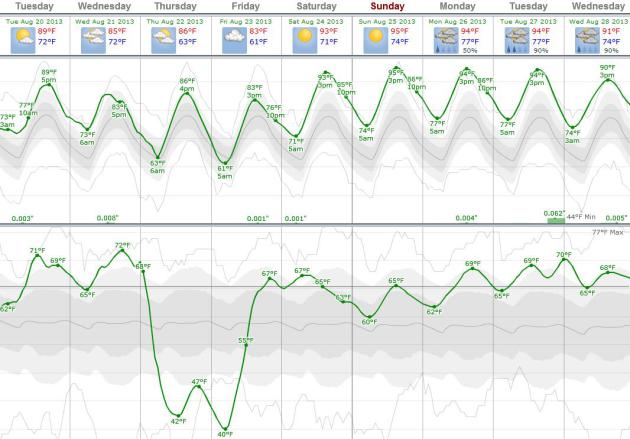 Peak Heat: Next Weekend Into Early Next Week?
Peak Heat: Next Weekend Into Early Next Week?
Today will be hot enough, low to mid 90s, but ECMWF guidance is hinting
at the main surge of heat pulsing northward into Minnesota and
Wisconsin from Saturday into Tuesday of next week; a few days in the
mid-90s can't be ruled out. The arrival of more comfortable air Thursday
(dew points drop into the 40s and 50s for 24 hours) may set off a few
strong T-storms late Wednesday and Wednesday night. Graphic above:
WeatherSpark.
 Slight Severe Threat Wednesday
Slight Severe Threat Wednesday.
Minnesota has experienced only 6 tornadoes, to date, according to SPC.
We should have seen closer to 25 by late August, but unusually cool,
dry, Canadian air took the edge of our severe storm risk from mid-July
into mid-August. We'll have enough low-level moisture for a few strong
storms tomorrow - wind shear is marginal, so there's a greater risk of
hail and straight-line winds than tornadoes. A cool frontal passage may
spark a few severe storms late Wednesday, according to
SPC.
 100-Degrees In September?
100-Degrees In September? I'm
not buying this solution (yet), but the GFS model predicts a run of 90s
from late August into the first week of September, going so far as to
print out a high of 100F on September 3. At this point that's more of a
"guess-cast" than a forecast, but we'll keep an eye on the trends, from
one model run to the next, and see if this extended heat spike is for
real. At the rate we're going we could make up for lost time (and heat).
Forecast Calls For Smoke.
NOAA
has a tool that allows you to see not only active fires, but the smoke
plumes generated by these wildfires. Smoke is thickest over Wyoming, but
as you can see the plume extends over 2,000 miles downwind, leading to
hazy/milky skies and a higher probability of taking in a Technicolor-red
sunset in the days ahead.
Active Wildfires.
ESRI has a good, interactive national map showing the location of current wildfires and additional information for each one: "
View
an interactive map of US wildfire locations, perimeters, fire
potential areas, global burn areas, wind conditions, and precipitation
via streaming data from NIFC, GeoMAC, NHSS, MODIS, METAR/TAF, and the
USDA Forest Service, Fire Modeling Institute."
Researchers Flying Over Western Wildfires, Sampling Smoke, To Study Role In Climate Change.
The Washington Post looks at how sampling smoke can give firefighters an upper hand on fighting these massive blazes; here's an excerpt: "
Researchers
are flying over Western wildfires to sample the thick smoke they emit
and study its role in cloud formation and climate. The data-gathering
campaign is intended to help scientists flesh out one of the least
understood areas of climate: the role of aerosols, or particles given
off by wildfires, and how they evolve over time. Biomass burning, such
as forest fires and agricultural fires when farmers burn off their farm
fields, has long been known to release large amounts of carbon
dioxide, a key greenhouse gas, but less is known about how smoke plumes
evolve over time and affect climate..."
Photo credit above: "
A view from the main fire camp of the Beaver Creek Fire burning on Friday, Aug. 16, 2013 north of Hailey, Idaho." (AP Photo/Times-News, Ashley Smith)
I've Never Seen This Before. Here's an
instagram
I received Monday, showing snow machines at Sun Valley Ski Resort in
Idaho being deployed to "keep things damp on Seattle Ridge".
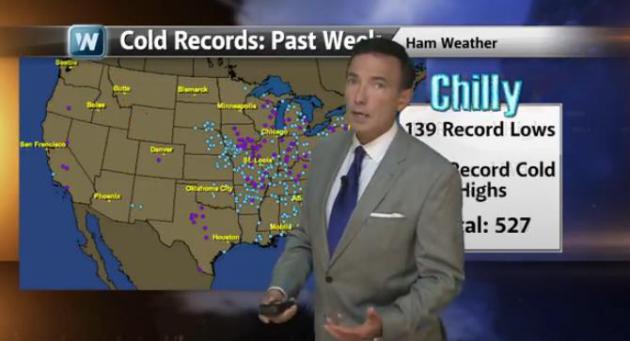 A Super-sized Summer.
A Super-sized Summer. Drought or flood, record heat or record chill, wildfires or sweatshirts? In today's edition of
Climate Matters
we take a look at some of the jaw-dropping extremes across the USA,
take a look at trends worrying U.S. Forest Service officials, and find
the one thing America doesn't have to worry about - at least not yet.
 10 Years Of Weather History In 3 Minutes
10 Years Of Weather History In 3 Minutes.
So long GOES-12. We'll miss you. A "planned retirement" of a weather
satellite that proved essential in recent years; details from
NOAA:
"
NOAA's GOES-12 satellite was decommissioned on August 16th, 2013 after
3,788 days in service. From April 2003 -- May 2010, GOES-12 served as
GOES East, providing "eye in the sky" monitoring for such memorable
events as the 2005 Atlantic hurricane season and the series of blizzards
during the winter of 2009-2010. After suffering thruster control
issues, GOES-12 was taken out of normal service and moved to provide
greater coverage of the Southern Hemisphere as the first-ever GOES
South. During that time it provided enhanced severe weather monitoring
for South America..."
Mysteriously Beautiful Cloud Swirls ("Von Karman Vortice") From Space? Here's a good explanation of what triggered this atmospheric squiggles from
NASA's Earth Observatory: "
Theodore
von Kármán, a Hungarian-American physicist, was the first to describe
the physical processes that create long chains of spiral eddies like
the one shown above. Known as von Kármán vortices
the patterns can form nearly anywhere that fluid flow is disturbed by
an object. Since the atmosphere behaves like a fluid, the wing of an
airplane, a bridge, even an island can trigger the distinctive
phenomenon. On May 22, 2013, the Moderate Resolution Imaging Spectroradiometer (MODIS) on NASA’s Terra
satellite captured this natural-color image of cloud vortices behind
Isla Socorro, a volcanic island located in the Pacific Ocean. The
island, which is located a few hundred kilometers off the west coast of
Mexico and the southern tip of Baja California, is part of the
Revillagigedo Archipelago..."
News Never Made Money, And Is Unlikely To. Can new
technology, e-distribution and personalization options make news
consistently profitable in the years ahead. Does Jeff Bezos have a few
tech-related tricks up his sleeve at The Washington Post? Here's an
excerpt of an Op-Ed at
Reuters: "
Sometime
in the mid-1990s, the Web began to peel from the daily American
newspaper bundle its most commercial elements, essentially the
editorial sections against which advertisements could be reliably sold.
Coverage of sports, business and market news, entertainment and
culture, gossip, shopping, and travel still ran in daily newspapers,
but the audience steadily shifted to Web sources for this sort of news.
Broadcasters had dented newspaper hegemony decades ago, absconding
with breaking news and weather coverage, and inventing new audience
pleasers, such as traffic reports and talk. But it was the Web that
completed the disintegration of the newspaper bundle that dominated the
news media market for more than a century. In addition to pinching the
most commercial coverage from newspapers, the Web has also made off
with the institution’s lucrative classified ads market, simultaneously reducing its status as the premier venue for content and advertising..."
Terrafugia Transition Flying Car Makes First Public Flights.
When I imagined the 21st century as a child "flying cars" was right up
there in my futuristic daydreams. We're getting closer to that day - but
I suspect the price has to come down (a lot) before Aunt Fern has one.
Here's a clip from
Gizmag: "
There was a ray of hope recently for those who are looking forward to a car that’s a bit more Blade Runnery as Terrafugia's Transition flying car
made its first public flights at EAA AirVenture in Oshkosh, Wisconsin.
There, the Terrafugia team conducted two 20-minute flight
demonstrations and also showed off the capability for the Transition's
wings to be folded up so it can be driven about like a car...."
Image credit above: "
The TerreFugia Transition performed a 20-minute demonstration flight at EAA AirVenture Oshkosh."
TODAY: Hot sun. Dew point: 70. Feels like 98. Winds: S 15. High: 93
TUESDAY NIGHT: Clear and warm. Low: 73
WEDNESDAY: Sticky sun, late-day T-storm possible. High: 92
THURSDAY: Partly sunny, breezy & cooler. Dew point: 54. Wake-up: 67. High: 82
FRIDAY: Early T-storm possible, turning sunny and warmer again. Wake-up: 64. High: 85
SATURDAY: Sweat-on-a-stick. Sunny and sizzling. Dew point: 71. Wake-up: 69. High: 92
SUNDAY: Sunny, even hotter. Feels like 100+. Wake-up: 73. High: 95
MONDAY: Tropical heat, isolated T-storm? Wake-up: 74. High: 94
Climate Stories...
A Solar System Is Installed In The U.S. Every 4 Minutes. Green Tech Solar has the article; here's a snippet: "
A lot happens in America every four minutes. During that short time period, 30 babies are born, 4,080 McDonald's Big Macs are consumed, and 48,000 tons of CO2 are emitted.
And as it turns out, the U.S. is now installing one solar photovoltaic
(PV) system every four minutes as well. If market growth continues at
its current pace, the American solar industry could be installing a
system every minute and twenty seconds by 2016. That's a dramatic
difference from 2006, when installers were only putting up one system
every 80 minutes. Shayle Kann, vice president of GTM Research, documents the accelerating speed of solar deployment in the chart (above)..."
Graphic credit above:
Source: Shayle Kann, GTM Research
Leaked Draft Of IPCC Report Ups Odds Man Causing Climate Change To 95 Percent. Here's a clip from
Politico: "
An
Intergovernmental Panel on Climate Change report due out next month
will say there's at least a 95 percent chance that human activities
(mostly burning fossil fuels) have been the main cause of global warming
since the 1950s, according to a draft version of the report seen by
Reuters. “That is up from at least 90 percent in the last report in
2007, 66 percent in 2001, and just over 50 in 1995, steadily squeezing
out the arguments by a small minority of scientists that natural
variations in the climate might be to blame. That shifts the debate onto
the extent of temperature rises and the likely impacts, from
manageable to catastrophic. Governments have agreed to work out an
international deal by the end of 2015 to rein in rising emissions.”
* more details on the upcoming IPCC report from Justin Gillis at the
New York Times.
With The Forthcoming IPCC Report, The Contrarians Finally Agree We Are Changing The Climate. Here's an excerpt of an article from St. Thomas's Dr. John Abraham at
The Guardian: "...
Some
items are worse than we thought. In the last report, ice loss,
particularly from Greenland, was a minor issue. Now, it is clear that
not only Greenland, but also Antarctica are melting and this melt is
raising sea levels. Furthermore, Arctic sea ice is being lost faster
than previously reported. The new report will likely have continued
questions. For instance, how will hurricanes change in a warming world (the most powerful hurricanes are becoming even more powerful, but the change in frequency is not known) is still an open question. Extreme weather
will be a mixed bag. Some extreme weather has certainly increased
(heat waves for instance, drought in certain areas, and heavy
precipitation events). Changes to tornadoes and thunderstorms? That is
one area that is highly uncertain..."
The Battle Over Global Warming Is All In Your Head.
Time Magazine has the story; here's the introduction: "
Today the scientific community is in almost total agreement
that the earth’s climate is changing as a result of human activity,
and that this represents a huge threat to the planet and to us.
According to a Pew survey
conducted in March, however, public opinion lags behind the scientific
conclusion, with only 69% of those surveyed accepting the view that
the earth is warming — and only 1 in 4 Americans see global warming as a
major threat. Still, 69% is a solid majority, which begs the question,
Why aren’t we doing anything about it? This political inertia in the
face of unprecedented threat is the most fundamental challenge to
tackling climate change. Climate scientists and campaigners have long
debated how to better communicate the message to nonexperts so that
climate science can be translated into action..."
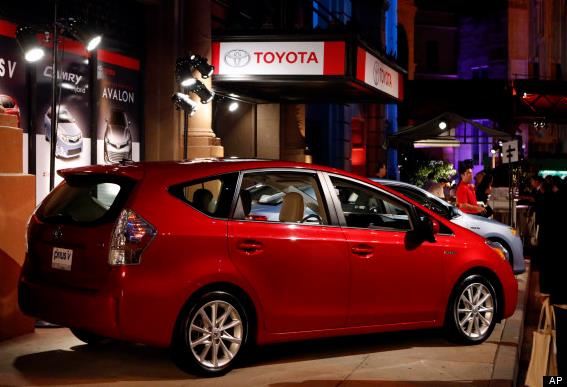 Here's How 16 Big Companies Are Profiting Off Global Warming
Here's How 16 Big Companies Are Profiting Off Global Warming. Here's a clip from Huffington Post:
"...
Automakers producing hybrid cars like Ford, Honda and General Motors could be poised to cash in if a pinched oil supply pushes gas prices up, according to a 2007 USA Today report citing Wall Street analyses. In addition, Toyota officials have noted on earnings calls that concerns over global warming help boost the company
because it's known for its fuel efficient and hybrid models like the
Prius. Other companies have found different ways to profit off making
our doomed future a little bit better for everyone. Take Daikin Industries, a maker of energy efficient air conditioners or Rayonier,
a timber supplier looking for ways to produce timber that don't release
carbon dioxide into the atmosphere. Those companies have a successful future in our new world, Nicolas Huber, the head of a fund that invests in companies poised to thrive in a hotter environment, told US News in 2008..."(Photo: AP).
Movements Without Leaders. Here's an excerpt of a
Huffington Post Op-Ed from 350.org founder and environmental activist Bill McGibbon: "...
What
I do sense, however, is that it’s our job to rally a movement in the
coming years big enough to stand up to all that money, to profits of a
sort never before seen on this planet. Such a movement will need to
stretch from California to Ecuador -- to, in fact, every place with a
thermometer; it will need to engage not just Chevron but every other
fossil fuel company; it will need to prevent pipelines from being built
and encourage windmills to be built in their place; it needs to remake
the world in record time. That won’t happen thanks to a paramount
leader, or even dozens of them. It can only happen with a spread-out
and yet thoroughly interconnected movement, a new kind of engaged
citizenry. Rooftop by rooftop, we’re aiming for a different world, one
that runs on the renewable power that people produce themselves in
their communities in small but significant batches. The movement that
will get us to such a new world must run on that kind of power too."




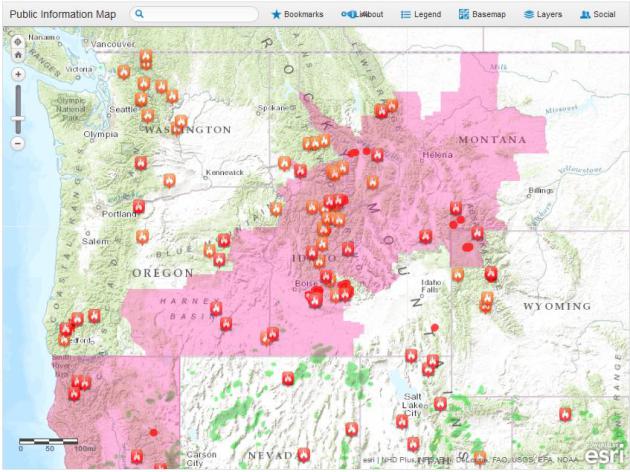
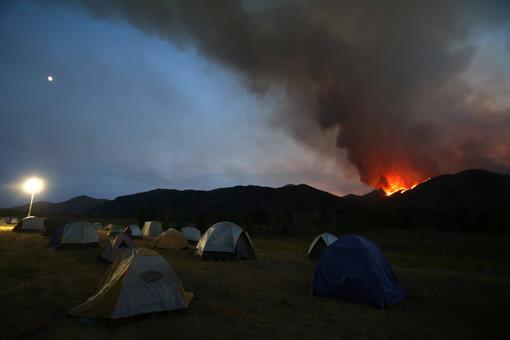
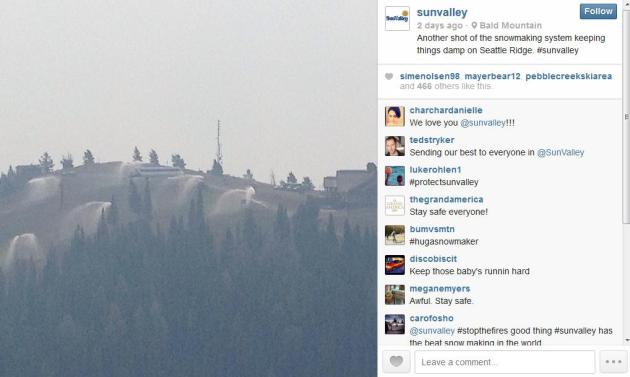




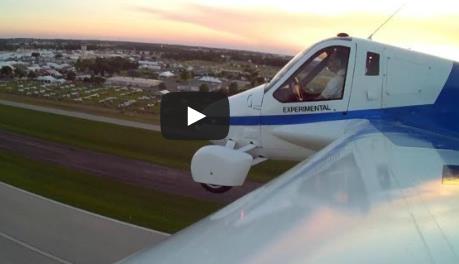








No comments:
Post a Comment